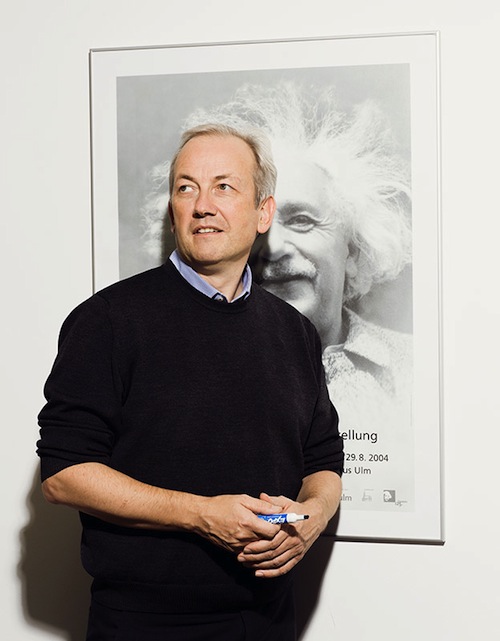Oberlack develops solutions for the precise simulation of turbulences

Turbulence makes life difficult for the designers of cars or aircrafts. It cannot be simulated with absolute precision. Martin Oberlack, head of Institute of Fluid Dynamics wants an original solution to the problem.
Albert Einstein grins impishly from a poster on the wall in Professor Martin Oberlack's office. Perhaps the genius already knew decades ago that his thinking would lend wings to machine construction engineers like Martin Oberlack and help them to solve apparently unsolvable problems involving aerodynamics. Martin Oberlack explains the problem troubling aircraft and car manufacturers using a diagram hanging on the wall in the corridor of the Institute of Fluid Dynamics on the Darmstadt Lichtwiese.
It looks like a brightly coloured abstract painting: a 5-metre long strip with smooth, even brush strokes dominating the left edge that become increasingly chaotic as they approach the right. In fact, it‘s almost as if the artist became less and less controlled as work progressed. But it‘s not a work of art. "It‘s a computer simulation of turbulence," says Professor Oberlack, and displays the vortices of air flowing over a flat panel. The vortices increase towards the right, that is as the gap to the panel increases. "That‘s why Business Class is at the front of an aircraft," he explains. Vortices at the back of the aircraft make that area noisier, adds the machine construction engineer.
Even supercomputers can not simulate turbulences with absolute precision
Noise isn‘t the only annoyance caused by turbulence. Vortices also cause air resistance, or drag, which increases fuel consumption. So the shape of a vehicle or aircraft should cause as few air vortices as possible. To establish the best shape, the developers experiment with various different versions in wind tunnels. Computers are also used to help with the design. All this effort, and it‘s still not quite enough. "Even the most powerful supercomputers in Germany can‘t simulate turbulence with absolute precision," explains Martin Oberlack. Why not: the less viscous a medium is, the tinier the tiniest vortices are. However, if you want to simulate the occurrence on a computer, it is needed to take vortices of all sizes into account.
Engineers are not interested in every single tiny vortex in the airflow, but in statistical sizes such as the average speed in the air at different distances from the surface, because air resistance can be calculated from this profile. "The tiniest differences in the speed profile matter," he says.
However, the subtle differences in the statistical values can only be derived from a complete simulation of the chaotic event – just as it takes lots of individual opinions in order for the results of a survey to be precise and reliable. This requires computers with vast memories and unimaginable computing speeds. And even though supercomputers are getting ever-faster and their memories ever-bigger, "It‘s still going to be about 50 years before they can calculate turbulence with a precision that eliminates the need for expensive experiments in wind tunnels," he adds.
In order to reduce computing time, the developers simplify their mathematical models using empirical assumptions that are based on experiments, but that makes the simulations inaccurate. "To an airline, though, the tiniest differences in kerosene consumption matter," he emphasises. And although there is a huge gap between this requirement for exact results and the precision of the simplified simulations, Martin Oberlack doesn‘t seem to be losing any sleep over it. That‘s because the gap defines his playing field. He and his 20-strong team are the only people in the world who are ploughing it with a new method. And they have solutions to offer.

 How to resolve AdBlock issue?
How to resolve AdBlock issue?